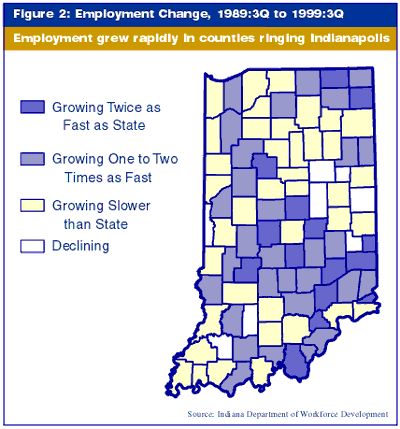Employment Gains Outpace Population Growth Across Indiana
According to new tabulations of workers covered under Indiana's unemployment insurance laws, statewide employment grew at a healthy pace between third quarter 1989 and the same quarter in 1999, increasing by nearly 461,000 to a total of 2.9 million. The employment gain of 18.8% over this 10-year period coincides with a 22.8% increase in establishments, suggesting that most of the growth has come from small businesses. The state added 25,674 establishments (employers) and 461,000 workers over the 10-year interval.
Figure 1 presents a comparison of 1989-99 employment gains and population change. It seems reasonable to expect that employment gains over the past 10 years would roughly approximate population increases for the same period. Census Bureau population estimates, with an annual reference date of July 1, provide the population benchmark.

The chart shows that while the state's population grew steadily over the 10-year interval, employment grew at a faster pace, especially in recent years. In fact, the state's employment gain of 461,000 workers was achieved with a population gain of only 419,000 people, an apparent deficit of 42,000 workers.
This deficit is easily explained, however, by the state's vigorous recovery from the recession of the early 1990s and the resulting drop in unemployment. Indiana's unemployment rate fell from 4.5% in August 1989 to 2.9% 10 years later, with 42,000 people moving off the state's unemployment rolls, presumably onto payrolls. Besides reducing the ranks of the unemployed, a strong economy also contributes to employment growth by attracting new entrants to the workforce, such as stay-at-home mothers who decide to work for pay. As the economy improves, increased demand for goods and services creates the need for even more labor.
Indiana's two largest counties in employment size had vastly different records on job creation over the 1989-99 period. Marion County led the state in total employment by a wide margin in both 1989 and 1999, stretching its lead by adding 85,000 jobs—more than any other county. Lake County ranked No. 2 in total employment for both years, but added only 8,000 jobs over the 10-year period to rank 14th in job growth.
The map in Figure 2 depicts the percent change in employment from 1989 to 1999 for each Indiana county. The introduction of riverboat casino gambling allowed Ohio County to boost employment by a phenomenal 277%, easily outdistancing all other counties. Indianapolis suburban counties, particularly Hamilton and Hendricks, experienced rapid expansion in employment, with large gains in services and retail trade. Employment grew 75%, mostly in services, in Harrison County, which is part of the Louisville metropolitan area. Decatur County was another standout, with a 70% rate of employment growth, primarily in services and manufacturing.
Click on map to see larger version with data.

Eight Indiana counties suffered employment losses over the 10-year period. Madison County lost the most jobs overall, including 5,800 manufacturing jobs, offsetting gains in most other industrial sectors. Randolph and Fayette also lost more than 1,000 jobs, mostly in manufacturing.
Despite the loss of manufacturing jobs and erosion of employment in a few areas, Indiana capitalized strongly on the nation's long economic expansion of the 1990s. Hoosiers can look forward to more of the same in the new century.
